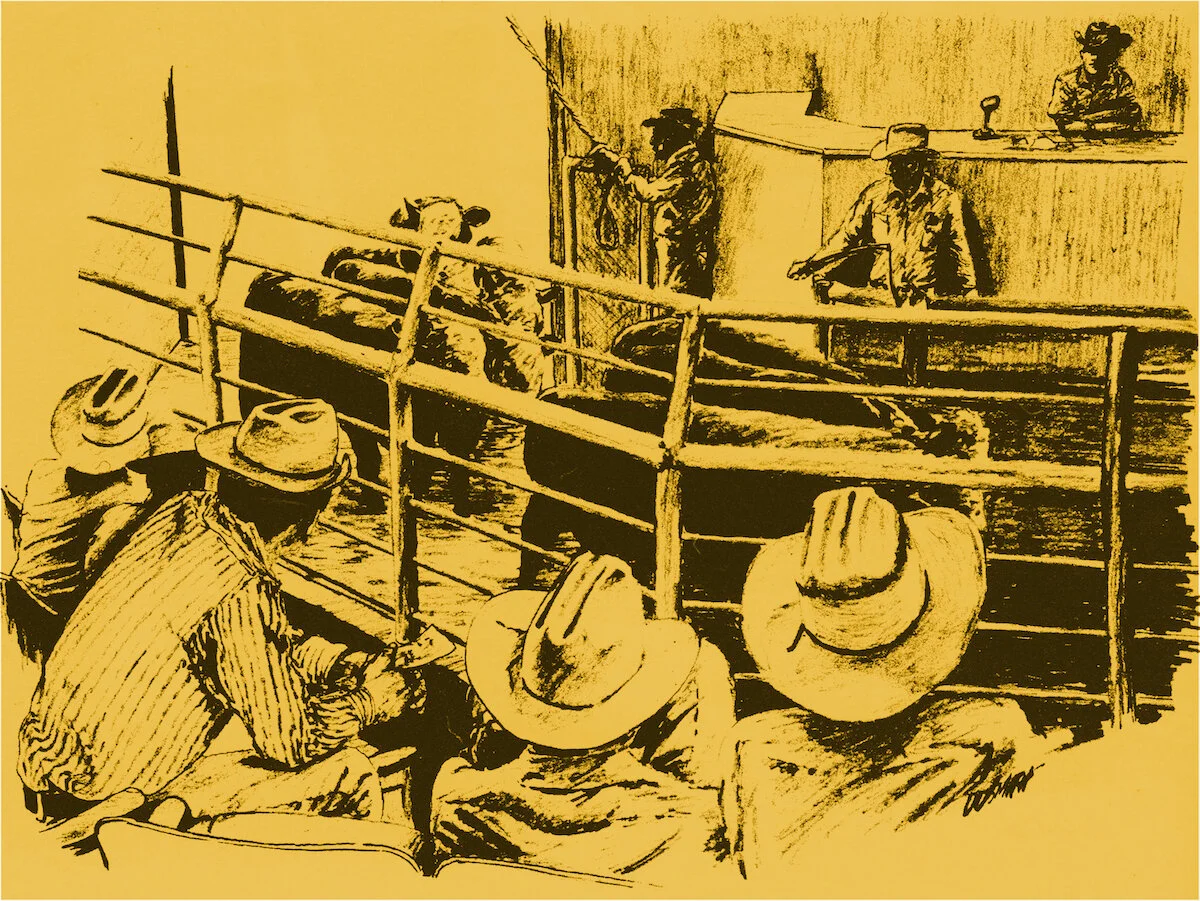(Reprinted from an article published in the early 1970’s in the Shorthorn World, The Brangus Journal, and the American Murray Grey News. Marketing aspects are somewhat different now, but overall this information “stands the test of time”.)
Anytime an individual enters the purebred cattle business, regardless of the breed, the future of the operation depends totally upon that individual, not on the breed of cattle. There is certainly a market for all breeds.
Too many times, a particular breed may be going strong at a given time and a new person is encouraged to enter the business since it looks like a gravy train. This may well be true in some cases, but these cases are extremely rare.
As a purebred breeder, any new or small established breeder must have goals for his operation. Incorporated in these, whatever they may be, are limiting factors which include acreage available for the operation, facilities for cattle handling, finances, and time available to work and promote the cattle.
Whether it is a part-time venture may play an important role in determining the size of the operation. Perhaps an additional factor that should not be overlooked is whether the venture must make a profit, if it is to be used as a tax shelter only, or if it is merely a hobby regardless of profit.
After a new breeder establishes his goals and embarks on his excursion, the future of his operation will hinge solely on his ability to successfully accomplish two items. First, the quality factor must be stressed in the brood cows as well as the herd sire. The breeder must be keenly aware of his association’s breed excellence requirements and strive to achieve this excellence. Too often a new breeder will purchase high quality females and then, for some reason or another, will purchase a bull of lesser quality that will not increase quality in his offspring. If this occurs, the future of the operation will certainly be jeopardized.
The only way to achieve quality is to study breed excellence requirements and know what he desires to start a small herd of cattle. Breed associations will certainly furnish ample material for the new breeder to study. Next, the breeder should begin to compare cattle that are for sale in terms of their excellence and then purchase the best cattle he can find for the money he has available. Visiting breed clinics, field days, and other ranches, as well as inspecting cattle at livestock shows are good ways to study the breed before starting a herd.
After the herd is started, a system of good records is essential to keep producing excellent quality. It is a must to keep weaning weights and production records on cows.
Since I have considerably discussed the cow herd, I would like to briefly mention the herd sire. Many times an excellent herd sire is the key to survival in a purebred operation. Probably the best cows in the country would be of little value if a bull does not transmit breed quality to his calves. Therefore, a breeder must decide to purchase a herd sire. Many bulls carry a price tag that prohibits the small breeder. With this in mind, the breeder must decide what he can afford to spend on a herd sire or if he should breed artificially. Artificial insemination methods allow small breeders to breed superior, proven bulls at a minimal cost. The time and facility factors again enter the picture as to the practicality of AI.
A good rule of thumb in purchasing a herd sire is to spend approximately twice the average price of your brood cows. At a later time, you may want to purchase a more superior bull. Whatever the decision, the selection of the herd sire should be a careful and well deliberated decision. The future of the small breeder may hinge on this single selection.
After the quality is considered, the marketing aspects enter the picture. You can breed the best cattle in the world, but if you can’t sell them, it doesn’t make a bit of difference. You cannot sit back and wait for your phone to ring and the buyers to beat your door down trying to buy your cattle. If you do, your future is in jeopardy. Any company that is a success and one that has been a success for many years is one that can market its product.
Many small purebred breeders ask “Where can I sell my bulls and heifers?” The future of the small purebred breeder lies in the ability of that breeder to market his cattle, more so than any other aspect of his operation. With this in mind, I would like to focus attention to the small purebred breeder marketing program.
Let me stress, however, that if the small purebred breeder cannot survive, then neither will the large breeder. The small purebred breeder is one of the chief purchasers of cattle from the large, established breeders.
To market cattle, the small breeder must look at collective marketing of his cattle. He should be a member of a local organization for his breed and collectively promote and sell their cattle. Keep in mind that more cattle are sold by working together. If there is not one in your area, form one. The area of a new association should probably cover a radius around a central point of approximately 150 miles. If all of the breeders in a centralized area work in competition for their breed, they will all perish. The market is there for all of the end products.
Another method of marketing cattle is to be an active member of your state and national or international associations. These associations are there to help you. Keep in touch with these groups by attending their meetings, functions and sales. Many leads for sales are picked up by the people attending these gatherings. Remember that an informed and knowledgeable breeder can discuss his produce much more intelligently.
Ninety percent of your sales will come from within a sixty mile radius of your operation, if they know you exist. To let them know you are there, advertise at least once each month in the classified advertising section of your local newspapers. This is not costly and will get your name established.
Place a ranch sign showing directions to your operation on roads and highways near you to direct people to you. These signs must have a picture of a bull or cow to attract attention. Many times your neighbors of three or four miles away will see your sign and visit with you to see what you have. This is a prospective sale.
Keep some kind of ad, no matter how small, in your breed journal. You need to let other breeders know you are in the business. This may lead to no more than two or three sales a year, but it will be worth the expense later down the line.
Each breeder should have a one page brochure with pictures of the operation, cattle, and herd sire, as well as directions to the ranch. When someone writes to you, you can mail a copy of this brochure. These should be reprinted about every three years and are of nominal cost.
Any person visiting your operation should be loaded with literature about your breed and your cattle before he leaves the place. A hand shake is nice as well as good conversation, but make sure your visitor leaves with either a purchase and/or a lot of material to think about when he gets home.
Take pictures of your best animals, have them reproduced at your local quick copy house and place them on bulletin boards at sale barns in your area. You might also call the breeder whom you purchased your cattle from and tell him what you have for sale. When you do make a sale, contact your buyers in 30 to 60 days to see how they are doing. Better still, if you have the time, drop by his operation and inspect your cattle with him. A satisfied customers will help you sell another customer, I will guarantee this in any breed.
If a customer comes to your ranch and wants an animal of a particular age and you are out of that age, contact other members of your local association and find out what they have have available. Once the animals are located, take the prospective buyer to your fellow breeder and help merchandize the cattle. It is customary for a breeder to pay a 5% commission to cover time and mileage for assistance with a sale. But this is entirely optional among breeders.
Attend local fairs whenever possible, display a couple of your best halter broken animals, preferably one bull and one female. Demonstrate your quality and good disposition. Make sure that your animals are in good shape and are truly representative of your herd. This will eventually lead to many future sales.
Contact your county agent as well as the many vocational agriculture teachers in your area and let them know when you have club calf prospects that could be used in junior shows. Have them and their students come out and visit your ranch. In many cases they want only the very best, but this is an opportunity to get your cattle in the show ring with no cost to you. If you have a Grand Champion, you’ll gain many future sales.
A point that cannot be stressed enough is that your bulls must be sold for what they are worth. You can’t sell cheap just to move them.
I have mentioned just a few ways to market cattle and I again want to emphasize that if the small purebred cattle breeder is to exist in this highly competitive work, he must stress his quality first. Once this is established the marketing aspect comes into play.



